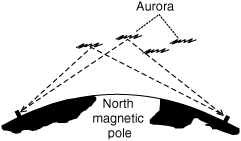aurora/auroral propagation
- aurora/auroral propagation
The phenomenon of the electromagnetic energy being returned to the earth as a result of unusual solar activity causing aurora. The aurora occur in the ionosphere. Theoretically, auroral propagation is possible, when the aurora are active, between any two points on the ground from which the same part of the aurora can be seen. Auroral propagation is characterized by rapid flutter, which makes voice signals such as AM (amplitude modulation), FM (frequency modulation), or SSB (single sideband) unreadable most of the time. This propagation method is highly unreliable.
In auroral propagation, electromagnetic energy is reflected from highly ionized auroral “curtains” above the north and south polar regions.
Aviation dictionary.
2014.
Look at other dictionaries:
List of radio propagation topics — This is a list of radio propagation terms. NOTOC A a index A index aa index active prominence active prominence region (APR) active region active surge region (ASR) active dark filament (ADF) AE index Air Force Geophysics Laboratory (AFGL) arch… … Wikipedia
Radio propagation — is a term used to explain how radio waves behave when they are transmitted, or are propagated from one point on the Earth to another. [ H. P. Westman et al, (ed), Reference Data for Radio Engineers, Fifth Edition , 1968, Howard W. Sams and Co.,… … Wikipedia
TV and FM DX — TV DX and FM DX is the active search for distant radio or television stations received during unusual atmospheric conditions. The term DX is an old telegraphic term meaning long distance. VHF/UHF television and radio signals are normally limited… … Wikipedia
ionosphere and magnetosphere — ▪ atmospheric science Introduction regions of Earth s (Earth) atmosphere in which the number of electrically charged particles ions (ion) and electrons (electron) are large enough to affect the propagation of radio waves (electromagnetic… … Universalium
geomagnetic field — Magnetic field associated with the Earth. It is essentially dipolar (i.e., it has two poles, the northern and southern magnetic poles) on the Earth s surface. Away from the surface, the field becomes distorted. Most geomagnetists explain the… … Universalium
plasma — plasmatic /plaz mat ik/, plasmic, adj. /plaz meuh/, n. 1. Anat., Physiol. the liquid part of blood or lymph, as distinguished from the suspended elements. 2. Cell Biol. cytoplasm. 3. whey. 4. a green, faintly translucent chalcedony. 5. Physics. a … Universalium
Cluster (spacecraft) — Cluster Operator European Space Agency in international collaboration with NASA Major contractors Dornier GmbH (now part of EADS) Mission type Orbiter Satellite of Earth … Wikipedia
Geomagnetic storm — This article is about disturbances within Earth s magnetosphere. For other uses of magnetic storm , see Magnetic storm (disambiguation). Solar particles interact with Earth s magnetosphere. A geomagnetic storm is a temporary disturbance of the… … Wikipedia
Ionosphere — The ionosphere is a part of the upper atmosphere, comprising portions of the mesosphere, thermosphere and exosphere, distinguished because it is ionized by solar radiation. It plays an important part in atmospheric electricity and forms the inner … Wikipedia
Double layer (plasma) — This article is about the structure in plasma physics. For other uses, see Double layer. Saturnian aurora whose reddish colour is characteristic of ionized hydrogen plasma.[1] Powered by the Saturnian equivalent of (filamentary) Birkeland… … Wikipedia
 In auroral propagation, electromagnetic energy is reflected from highly ionized auroral “curtains” above the north and south polar regions.
In auroral propagation, electromagnetic energy is reflected from highly ionized auroral “curtains” above the north and south polar regions.